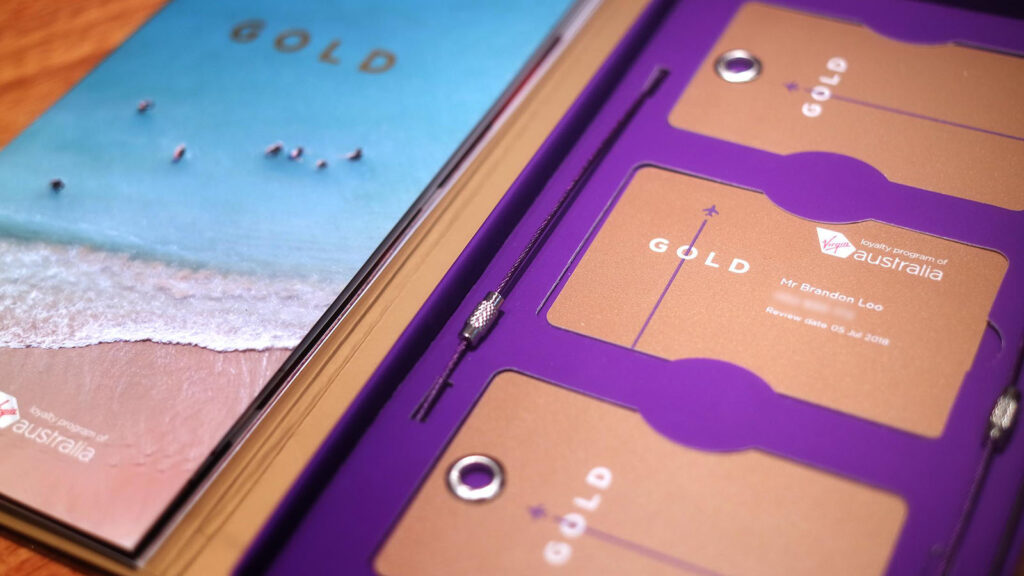Status Credits are at the crux of most frequent flyer programs: and it pays to know how to maximise your haul. Collect enough of them within a 12-month period and you’ll be elevated to an elite tier, earning new benefits and privileges that make life in the air (and on the ground) a lot more enjoyable.
Virgin Australia’s Velocity Frequent Flyer is a great program to get into for the not-so-frequent flyer, as there are a few tricks you can use to climb the status ladder faster.

Velocity status tiers at a glance
Ultimately, you have to spend money to earn Status Credits, as they are a measure of how valuable you are to the airline. Therefore, the goal of most travellers is to maximise the number of Status Credits they can earn while trying to minimise the cost.
By simply dividing the fare with the number of Status Credits earned, we can have a simple comparison of the cost per Status Credit across a range of different fares, which we’ll use in this article.
Maximise your Status Credits on Virgin Australia flights
A short domestic flight on the cheapest ‘Lite’ fares would net you a mere five Status Credits, while paying for a fully changeable ‘Flex’ fare would earn you 25 Status Credits. But it pays to look at Business Class too, because these fares can sometimes cost less than Flex Economy, while being more rewarding. This can help you to maximise your Status Credits.
| Virgin Australia Sydney to Melbourne (one-way) Status Credit comparison |
|||
|---|---|---|---|
| Fare Type | Ticket Price (average) | Status Credits | Cost per Status Credit |
| Lite | $109 | 5 | $21.80 |
| Choice | $119 | 15 | $7.93 |
| Flex | $433 | 25 | $17.32 |
| Business | $369 | 55 | $6.71 |
As you can see from the table, Lite fares are quite an uneconomical way to rack up Status Credits, costing over $21 per Status Credit at these prices. On Virgin Australia’s international flights, Lite fares are also the costliest way to build a balance of Status Credits, despite being the cheapest fare on each flight. Here’s what we mean.
Virgin Australia Cairns to Tokyo (return) Status Credit comparison |
|||
|---|---|---|---|
| Fare Type | Ticket Price (average) | Status Credits | Cost per Status Credit |
| Lite | $589 | 25 | $23.56 |
| Choice | $664 | 45 | $14.76 |
| Flex | $1,395 | 65 | $21.46 |
| Business | $2,679 | 140 | $19.14 |
Booking a connecting flight to maximise Velocity Status Credits
‘Why fly direct when you can connect’ is a phrase often quoted within the frequent flyer community. This refers to the practice of flying via a secondary city instead of flying direct. That way, you’ll earn Status Credits for two flights, instead of one.
For example, let’s consider Perth to Sydney on a direct flight:
| Virgin Australia Perth to Sydney (one-way) Status Credit comparison | |||
|---|---|---|---|
| Fare Type | Ticket Price (average) | Status Credits | Cost per Status Credit |
| Lite | $229 | 20 | $11.45 |
| Choice | $259 | 35 | $7.40 |
| Flex | $719 | 50 | $14.38 |
| Business | $1,726 | 110 | $15.69 |
Now consider flying indirect, Perth to Sydney connecting via Melbourne:
| Virgin Australia Perth to Melbourne to Sydney (one-way) Status Credit comparison | |||
|---|---|---|---|
| Fare Type | Ticket Price (average) | Status Credits | Cost per Status Credit |
| Lite | $316 | 23 | $13.74 |
| Choice | $366 | 45 | $8.13 |
| Flex | $744 | 70 | $10.63 |
| Business | $1,751 | 140 | $12.51 |
At the fare prices quoted, this method drives up the cost per Status Credit on lower and mid-range fares. But on Flex tickets and Business airfares, the price difference is negligible and the journey becomes noticeably more rewarding. Of course, when flying round-trip, those extra Status Credits become even more noticeable.
Doing a status run to maximise Velocity Status Credits
These aren’t for the faint-hearted, and it takes a lot of effort to find one that suits you. Essentially, savvy travellers will book a string of connecting flights for the sole purpose of collecting and maximising Status Credits, often doing a return trip in one day for this reason alone.
However, with these runs, you can often pick up a lot of Status Credits for a reasonable cost. You could look to the domestic skies for something simple, or zip across to one of Virgin Australia’s international destinations such as Queenstown.
American Express Velocity Platinum
While status runs can be useful for maintaining your membership, we’d discourage anyone from spending a day or two flying around just to rack up Status Credits. It’s not great for the environment, for one. And let’s be honest. If you’re booking flights for the sole purpose of gaining or retaining status, it probably means you’re not otherwise travelling enough to make full use of that status anyway.
But if you can integrate it into a holiday, and get some meaning out of your travel, then you’ll definitely find the whole experience a lot more enjoyable, rather than a chore.
Eligible Sectors are important, too
In order to reach or maintain status, you’ll also need to fly a number of Eligible Sectors. These are flights that begin with a VA number which are paid for in dollars (note: not reward seats). Eligible Sectors can’t be pooled, so the person collecting Status Credits must accrue these eligible sectors themselves.
This is easily done on Virgin Australia domestically through indirect connections. For instance, Perth – Melbourne – Sydney return will collect four eligible sectors.
You can also travel on partner airline codeshare flights booked with a VA flight number, as these count as Eligible Sectors too. Bookings for these can be made through Virgin Australia’s website.

Other methods of building Status Credits
Family Pooling
Family Pooling is where you and eligible family members can pool points and Status Credits into a single account. It’s perfect for family holidays, although there’s a limit of two adults per family pool including the beneficiary. (In other words, only one adult can pool into your account). On top of that, everybody in a pool must live at the same address.
Grocery shopping
You’ll earn one Status Credit for every $100 you spend at Coles, Coles Online, Liquorland and First Choice Liquor through flybuys, up to 10 Status Credits per month. Just make sure you’ve linked your Velocity and flybuys accounts.
While this doesn’t seem like a lot, a few months of buying groceries could give you just enough Status Credits to cross the line and achieve the next status level.
Flying with partner airlines
Read our full guide to maximising Velocity Status Credits by flying on partner airlines.
My case
Previously, when I was a full-time university student, I could only travel during my semester breaks. However, I had already achieved Velocity Gold status and was right on track to reach Platinum by the end of 2017, simply with a combination of the following:
- Family Pooling
- Flying between Perth and the East Coast through secondary cities
- Buying Economy Flexi Saver tickets on Singapore Airlines
- Topping up with shopping at Coles via flybuys

Making the most of the semester break: 443 SCs earned in July 2017
Summing up
Frequent flyer programs can be difficult to get your head around, especially for more advanced concepts such as maximising your Status Credits earn.
But it just takes some practice and research, and soon you could be turning your annual family holiday into an adventure, with a sparkling new Velocity Gold or Platinum membership awaiting your return.
Also read: A comprehensive guide to Virgin Australia upgrades
Additional reporting by Chris Chamberlin.
Stay up to date with the latest news, reviews and guides by subscribing to Point Hacks’ email newsletter.







I’m about 10 SC’s of being able to gift Gold status to my spouse(I’m on Platinum). We’ve got a month to get this additional 10 SC.
We have family pooling, just wondering if SC’s from flybuy shopping are pooled as well? ie, will her SC from her spend on her flybuy card be pooled into our family account if I link her card to her VA FF account?
I’m on VA Gold and have 913 SCs now with a review date of 27 Sept 2019. I’m flying return SYD-KUL with VA (SIA operated) on 21-23 September. This trip should just get me over the 1000 SCs needed to obtain Platinum on VA.
Do you guys have an experience with the timing of the points coming in and being counted during the review date?
Do you know if it’s counted by activity date or processed date?
If it’s processed date, do you think I have enough time between the activity date and review date for it to be counted (because my experience is that it takes a few days for the SCs to be processed in the account)? If not, do I have a case to appeal to say that I’ve flown enough to be bumped up to Plat?
I’ve got a couple of questions regarding VA’s Velocity programme and need some advice on what my best options are:
Now that I’ve reached Gold using family pooling, should I try for Platinum as I don’t see much benefit/difference to Gold, and perhaps I should instead transfer the family pooling to my partner, who’s at Red currently (we generally travel together as a family), to get her to Silver then Gold?
Or should I keep the family pooling with my account so that I can reach the adequate number of SC’s required for the following year?
We do travel overseas once a year, so the only advantage of both of us holding Gold status is that it would allow both adults and both kids into partner lounges like in Changi, Singapore. Otherwise, most of our travel is domestic.
I was also wondering what happens when one accumulates adequate SCs and eligible sectors(ES) to maintain the tier status for the following year? Does it automatically renew for another 12 months at the date that Gold status was achieved initially? For example, if I achieved Gold status on 01/10/17 and accumulated adequate SC and ES by 28/12/2017 to maintain Gold status, would my Gold status then only expire on 30/9/2019?
Thanks for your help.
When you have kids, I think it’s beneficial for both partners to have Gold rather than one person to have Platinum – as you say, it gives more guesting rights in places like Singapore (where Gold and Platinums share the same lounge anyway)..
So I would recommend once you reach Gold, to redirect all the points to your partner. Assuming your kids are under 18, all their travel can pool as well as your own.
Once you requalify for another year, it’ll get added on at the end of your review date. So if you initially qualify on 01/10/17 and maintain on 28/12/17, then on 01/10/18 you’ll automatically be renewed until 01/10/19, and you’ll have to maintain status again within that year.
Thanks for your reply mate.
Unfortunately what’s happened is that is was just less of a couple of hundred points short of earning enough SC with to maintain my Gold but as we were on family pooling, our next overseas trip with SQ/VA codeshare, pushed me into Platinum…which I was hoping to avoid so I could switch the family pooling to my wife.
Anyway, I’ve got to try and maintain my Platinum status now. I remember you mentioned that once one reaches a certain level of SC on Platinum, one can gift a Gold membership to one’s partner? Is that correct? What level of SC is it? Do you have to qualify to maintain and then go above that level before gifting?
Thanks again for your advice.
Cheers!
The threshold for gifting a Companion Gold membership is when you earn 500 SC above requalifying for Platinum – thus 500 SC over 800 SC = 1300 SC in your Platinum year.
To keep VA platinum, CX marco polo, KE morning Calm membership tier, I fly over 200,000 miles in 2 years since march 2016.
Love the ability to pool points and Status Credits.
Have you worked out the cash difference you are paying – vs in every scenario if you flew the cheapest airline?
Yes, status credits from Flybuys will automatically transfer a few days into each new month.